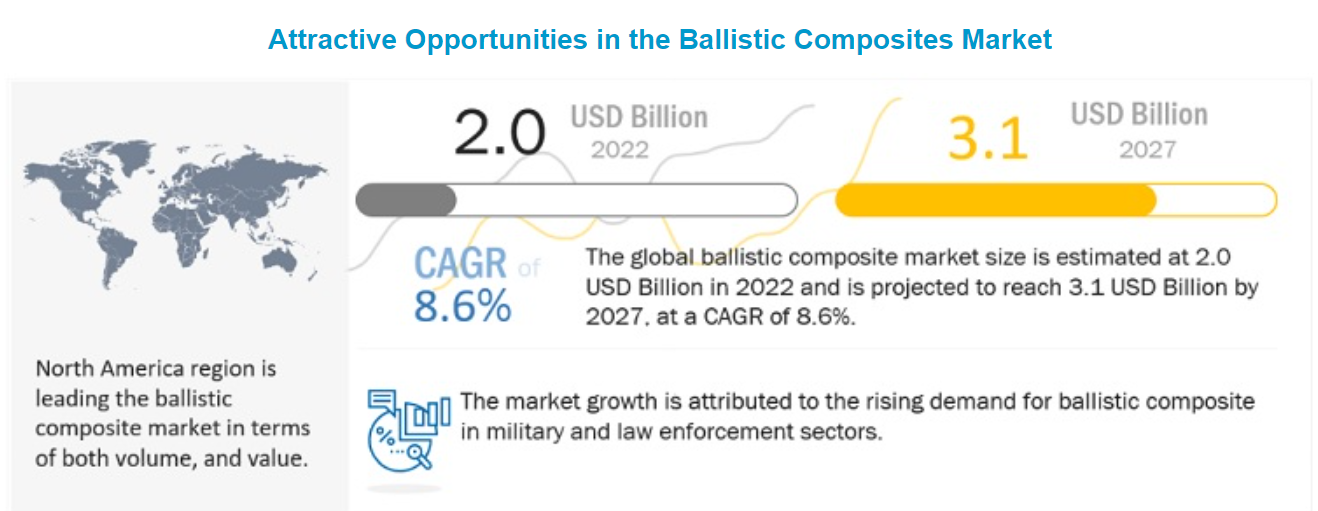
The global ballistic composites market is expected to reach USD 3.1 billion by 2027, growing at a CAGR of 8.6%. The ballistic composites market is growing due to rising demand from military and law enforcement sectors. Although, the increase in demand for ballistic composites is due to the huge demand for high performance materials.
Global Ballistic Composites Market Dynamics

Driving factor: increasing demand for personnel protection
Increasing criminal and terrorist activities are driving the demand for ballistic body armor and vehicle armor for political leaders, businessmen, bureaucrats, prominent athletes, entertainment celebrities, and others. Demand for composite materials for personal protective clothing and transportation is surging as ballistic composite armor is lighter and meets the highest requirements of international security standards. Several companies are working to add composite armor to luxury passenger vehicles designed for civilians by automakers such as Mercedes-Benz and Lexus.
Constraints: High costs and extremely stringent standards
The high cost of new technologies is a major factor restraining the growth of the ballistic composites market. Companies are investing heavily in the development of ballistic composite products and solutions to meet the growing challenges posed by new lethal munitions. However, these new products and solutions are very expensive, thus resulting in low industry penetration.
Opportunity: Evolution and Adoption of New Technologies and Products
Military research laboratories are experimenting with the incorporation of multifunctional ballistic materials into soldiers' protective clothing. These materials have conductive properties and are expected to monitor a soldier's heart rate. These research labs are working to build antenna communications directly into composite body armor to reduce its weight. Some companies are also using nanotechnology to improve the ballistic performance of composite materials.
Challenge: Developing durable ballistic composites based on the threat
The biggest challenge in designing ballistic composites is evaluating their performance in different combat situations. Manufacturers must develop composite panels and armor that provide high levels of toughness, fracture resistance and ballistic protection without delamination. For example, body armor must be designed so that they can deflect bullets from different types of firearms, while armored vehicles should be able to withstand projectiles, roadside bombs and shells fired by tanks.
The vehicle armor product type holds the largest market share in terms of volume in the global ballistic composites market
Weight savings for a given level of strength make the use of composites in vehicle armor product types critical. Different end-use sectors are focusing on reducing weight and increasing the strength of ballistic composites as well as developing more advanced materials. Vehicle armor is equipped with ballistic composites to ensure a high level of protection against ballistic impact. The United States, China and Germany are the most lucrative markets.
In terms of value and volume, aramid fibers are the major segment of the market
Due to its superior properties such as strength, flexibility, durability, stability, light weight, and resistance to heat, temperature, and moisture, aramid fiber has different applications in military and homeland security. It is used in the manufacture of different products such as vehicle armor, body armor, helmets and face shields. The demand for aramid fiber ballistic composites is expected to grow due to their lightweight and corrosion resistance properties.
Polymer matrix accounts for the largest share of ballistic composites in terms of value and volume
In the matrix type segment, polymer matrix type dominates the ballistic composites market. Polymer matrix ballistic composites have properties such as high durability, low weight, high friction, and high temperature resistance. However, the most common thermosetting resins used in ballistic composites are modified phenolic resins, epoxy resins, and unsaturated polyesters, while the most common thermoplastic resins are polypropylene (PP), polyphenylene sulfide (PPS), bismaleimide (BMI), and polyurethane.
Military applications account for the largest share by value and volume
Based on application, the ballistic composites market has been segmented into military, homeland security, and others (private securities). Military applications account for the largest share of the ballistic composites market. Most casualties occur during military battles due to debris caused by explosions. Homeland security and military personnel require advanced ballistic protective equipment made of composite materials such as body armor and other personal protective equipment to protect them from ballistic threats while performing their duties. Rising geopolitical tensions in emerging economies such as India, South Korea, and Pakistan, along with changing battlefield scenarios, are fueling the growth of the ballistic composites market.
North America to hold the largest market share in ballistic composites market by 2021
North America is the major consumer of ballistic composites due to high demand from the U.S. and other countries. The major product types of ballistic composites in the North American market include vehicle armor, body armor, and helmets. Advancements in technology, regulatory policies, and government norms are some of the major factors driving the North American ballistic composites market.
Previous: no more
Next: no more